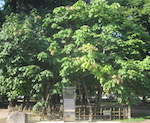
Two Domes: (Above) The A-bomb dome (Gembaku Domu) across the river from Hiroshima Peace Memorial Park. It had been an industrial promotion hall; it is now a UNESCO World Heritage site.
|
The Ginkgo Trees of Hiroshima'Phoenix trees' that survived the A-bomb blast,
|


|
|||

(Above) The nearest ginkgo to the hypocentre, at 1.13 km, is in the temple Hosen-ji, on an island in the Honkawa River just across from Peace Memorial Park. There are a number of temples in the area (Tera-machi) and it was busy with funeral traffic at the time I visited. This tree appeared to have lost its plaque at the time. 
|

 
(Above) The next closest, at 1.37 km, is in a completely contrasting setting, the beautiful Shukkeien Garden, where it stands on a knoll above a tranquil lake, not far from Hiroshima Station. It was the only tree to survive in the garden, as the plaque indicates, and the lean on it is obvious in the photo. (It is no 'giant' by ginkgo standards.) |
  (Above) The ginkgo is just visible up to the right of the pavilion on the lake. The plaque visible amongst the vigorously sprouting foliage in the lower photo is the standard phoenix tree plaque; examples are shown for various trees below. 
|
|||

|
 (Left) The third ginkgo, at 1.42 km, is in front of another temple, Josei-ji, an unassuming building on the bank of the Honkawa River. The standard phoenix tree plaque (above) is attached. There is a fourth ginkgo, at 1.65 km, in the grounds of Senda Elementary School. It is not far from Josei-ji. Unfortunately that hot afternoon took its toll and I stuffed up finding it. After finding Josei-ji I walked to Senda Park all right but did not go far enough along the tram route. I realised my mistake later that day, but too late, as there was no time to go back. I was no more than 100 metres from the tree : (( |
 Josei-ji gave some welcome shade on a hot afternoon. 
|
|||
 (Above) The fifth ginkgo, at 1.78 km, is in the temple Myojoin. I found it in the late afternoon, the golden light of the sun from the south-west, the direction of the blast, recalling another fateful moment in its life. |
 
|

|
|||

|
 The sixth and final ginkgo on my quest, at 2.16 km, is again in a temple, Anraku-ji, also near the river bank. |

| |||
 |

There are a number of other 'phoenix trees' around Hiroshima. The ginkgos are by no means the champion survivors when it comes to nearness to the blast. Better on that score is this camphor tree (left), at a mere 490 metres from the hypocentre, just off Peace Boulevard. (There is at least one tree closer.) 
|
 
A short distance from the camphor, right on Peace Boulevard, there is a small grove of trees at 530 metres, all survivors. They include Japanese hackberry (on the left in the top photo; see the plaque), and a clump of muku trees, Japanese bead trees, Japanese persimmon, and Kurogane holly. Other isolated examples of these trees are scattered around the within a kilometre or so of the hypocentre. |
|||
 |
 |
 |
|||
| Some other interesting phoenix trees are in the parkland surrounding the old Hiroshima Castle, less than a kilometre north of the hypocentre. Next to the southern section of the moat is a Eucalyptus (above) (with two of its leaves), and slightly further back overlooking the water, a pussy willow (far right).
A little further away, up toward the castle at 910 metres, is another Kurogane holly ((below). |
 |
 |
|||
 |
 |
 
And finally, there are two examples near the north side of the Hiroshima Peace Memorial Museum. The Chinese Parasol Tree (above left) was at 1.3 km from the hypocentre, and some Crinum Lilies (above right) which were at 2.2 km. Both of these were later transplanted into the positions where they are now. |

